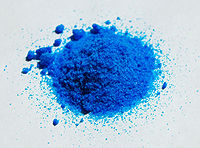
Photo from wikipedia
Alloy catalysts under reaction conditions are complex entities. In oxidizing atmospheres, multiple phases can coexist on a catalyst’s surface as a result of phase segregation and preferential oxidation. Such a… Click to show full abstract
Alloy catalysts under reaction conditions are complex entities. In oxidizing atmospheres, multiple phases can coexist on a catalyst’s surface as a result of phase segregation and preferential oxidation. Such a scenario can result in unusual substoichiometric and metastable phases that could play important roles in catalytic processes. For instance, AgCu alloys—known to exhibit enhanced epoxide selectivity in partial oxidation of ethylene—form an oxide-like surface structure under reaction conditions. Under these conditions, copper oxides are stable, while silver oxides are not. Consequently, copper segregates to the alloy’s surface and forms an oxide overlayer. Little is known about the structure or function of such overlayers, and it is unknown whether they play an active role in the catalyst’s enhanced selectivity. In order to develop a clearer picture of such catalysts, the current work utilizes several in situ spectroscopic and microscopic techniques to examine the copper oxide phases that form when A...
Journal Title: ACS Catalysis
Year Published: 2018
Link to full text (if available)
Share on Social Media: Sign Up to like & get
recommendations!